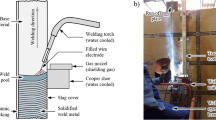The fluid dynamics of a straight tundish was studied when Ar-gas was fed through the bottom, using mathematical simulation. Flow rates of 15 and 40 liters/min of argon in three locations into the tundish – near input steel, center, and near output steel – were analyzed. A stochastic model was employed for determining statistically the particle amount (emulating alumina particles) in the inclusions removal. From these calculations and those of the Residence Time Distribution (RTD) curves, we found a direct relationship to improve steel quality. Specifically, removal of the smaller nonmetallic inclusions was significantly enhanced for cases with the lowest dead volume fraction; they correspond to those of the highest averaged residence time. Therefore, it was found that it is even possible to reduce argon consumption and still obtain good results of steel cleanness.










Similar content being viewed by others
References
I. Tsubokura, D. Sommerville, and A. McLean, “Factors influencing the effectiveness of tundish metallurgy,” Iron Steelmaker, 12, No. 5, 58–62 (1985).
C. Marique, A. Dony, and J. Mahieu, “The bubbling of inert gas into the tundish – a means to improve steel cleanliness,” Iron Steelmaker, 17, No. 9, 15–16 (1990).
D. Mazumdar and R. Guthrie, “The physical and mathematical modelling of continuos casting tundish system,” ISIJ Int., 39, No. 6, 524–547 (1999).
A. Ramos-Banderas, R. D. Morales, L. Garcia-Demedices, and M. Diaz-Cruz, “Mathematical simulation and modeling of steel flow with gas bubbling in trough type tundishes,” ISIJ Int., 43, No. 5 653–662 (2003).
A. Ramos-Banderas, R. Morales, J. de J. Barreto, and G. Solorio, “Modelling study of inclusions removal by bubble flotation in the tundish,” Steel Res. Int., 77, No. 5, 325–335 (2006).
D. S. Kumar, T. Rajendra, R. Prasad, et al., “Forced flotation of inclusions in tundish,” Ironmak. Steelmak., 36, No. 6, 470–475 (2009).
A. Cwudzinski, “Numerical simulation of steel flow through a one strand slab tundish with steel flow control devices,” Can. Metall. Q., 49, No. 3, 63–72 (2010).
J. Méndez, C. Cicutti, A. Martin, et al., Utilización de Barreras de Argón en el Distribuidor para mejorar la limpieza de Inclusión en Planchones de Colada Continua, CONAC, Monterrey, México (2010).
J. Jiang, J. S. Li, H. J. Wu, et al, “Water modeling of molten steel flow in a multi-strand tundish with gas blowing,” Int. J. Miner., Metall. Mater., 17, No. 2, 143–148 (2010).
J. de J. Barreto, G. Barrera, and C. Orozco, “Modelación física anisotérmica del flujo de acero usando inhibidores de turbulencia y cortinas de argon en el distribuidor de colada continua,” Memoria del XX Simposio Nacional de Siderurgia, Morelia, México (1999).
L. Zhang and B. G. Thomas, “State of the art in evaluation and control of steel cleanliness,” ISIJ Int., 43, No. 3, 271–291 (2002).
A. Vargas-Zamora, J. Palafox-Ramos, R. D. Morales, et al., “Inertial and buoyancy driven water flows under gas bubbling and thermal stratification conditions in a tundish model,” Metall. Mater. Trans. B, 35B, No. 2, 247–254 (2004).
L. Zhong, L. Li, B. Wang, et al., “Fluid flow behavior in a slab continuous casting tundish with different configurations of gas bubbling curtain,” Ironmak. Steelmak., 35, No. 6, 436–440 (2008).
G. Solorio-Díaz, A. Ramos-Banderas, J. de J. Barreto, and R. Morales, “Modeling study of turbulent flow effect on inclusion removal in a tundish with swirling ladle shroud,” Steel Res. Int., 80, No. 3, 223–234 (2009).
T. J. Chung, Computational Fluid Dynamics. Cambridge Univ. Press, New York (2010).
Y. Sahai and T. Emi, “Melt flow characterization in continuos casting tundishes,” ISIJ Int., 36, No. 6, 667–672 (1996).
M. Collur, D. Love, and B. Patil, Proceedings of the 80th Steelmaking Conference, I&S Society AIME, Warrendale (1997).
Acknowledgements
The authors give thanks to CONACyT, DGEST, ITM, FIM-UMSNH and CÁTEDRAS CONACyT for their continuous support.
Author information
Authors and Affiliations
Corresponding author
Additional information
Russian translation published in Metallurg, No. 12, pp. 20–28, December, 2017.
Rights and permissions
About this article
Cite this article
Aguilar-Rodriguez, C.E., Ramos-Banderas, J.A., Torres-Alonso, E. et al. Flow Characterization and Inclusions Removal in a Slab Tundish Equipped with Bottom Argon Gas Feeding. Metallurgist 61, 1055–1066 (2018). https://doi.org/10.1007/s11015-018-0607-0
Received:
Published:
Issue Date:
DOI: https://doi.org/10.1007/s11015-018-0607-0




